Great write up! Very thorough. Does the VLOM have a wire harness connector? I've never worked on one. If not, them maybe getting the non-afm valley plate would work? It's super easy with o-rings that block off the stand pipes. Also, to those in the know, what would happen on an AFM motor if the non-afm plate was installed? Would it basically prevent V-4 and throw a code. What would happen?
You are using an out of date browser. It may not display this or other websites correctly.
You should upgrade or use an alternative browser.
You should upgrade or use an alternative browser.
2013 Escalade ESV Next BIG adventure: Cooling system refresh, Big 3 Electrical upgrade, Reseal intake, and VLOM mod...
- Thread starter skpyle
- Start date
Disclaimer: Links on this page pointing to Amazon, eBay and other sites may include affiliate code. If you click them and make a purchase, we may earn a small commission.
donjetman
Full Access Member
- Joined
- Oct 22, 2018
- Posts
- 1,374
- Reaction score
- 2,388
YesDoes the VLOM have a wire harness connector?
Bad things would happen. Non AFM cam swap is required to run the non-AFM smooth VLOM, and AFM needs to be tuned out/turned off.If not, them maybe getting the non-afm valley plate would work? It's super easy with o-rings that block off the stand pipes. Also, to those in the know, what would happen on an AFM motor if the non-afm plate was installed? Would it basically prevent V-4 and throw a code. What would happen?
Thank you for the clarification, but I guess I'm wondering from a basic fluid/mechanical perspective, with the oil passages blocked, would it just prevent the actuation of the lifters since they are pressure activated? Codes would be a given at that point since there is a wiring harness, but would it default to just stay in V8 with a CEL on?Yes
Bad things would happen. Non AFM cam swap is required to run the non-AFM smooth VLOM, and AFM needs to be tuned out/turned off.
skpyle
Full Access Member
- Joined
- May 15, 2021
- Posts
- 395
- Reaction score
- 1,025
Because I can't leave well enough alone, I have answered the question nobody asked: What does a VLOM look like disassembled?
I took it apart. Mainly to do some cleaning. All parts except the solenoids, electrical bridge, gasket, and the electrical connector receptacle were soaked and then scrubbed in my parts washer. The solenoids and connector receptacle were wiped off with brake cleaner soaked rags. The bridge and gasket were quickly scrubbed in the parts washer and set to try.
My intent was not to get the parts surgically clean, but to remove the worst of the crud.
Word of caution: I had initially sprayed the gasket with brake cleaner and then wiped it off. Nothing bad happened. However, once I scrubbed it in the parts washer, the rubber elements started swelling. I hosed it down with brake cleaner again and wiped it off. After a couple of hours of drying, most of the rubber elements shrank back. That which was a little loose, I pushed back into place just before installing the gasket back on the VLOM plate. Honestly, I am not overly concerned about this. The center section gasket rubber elements sat properly in the plastic frame. More importantly, due to the sleeve I pressed into the oil pressure sending unit bore as part of the 'VLOM Mod', there is not supposed to be any oil pressure at the solenoids anymore.
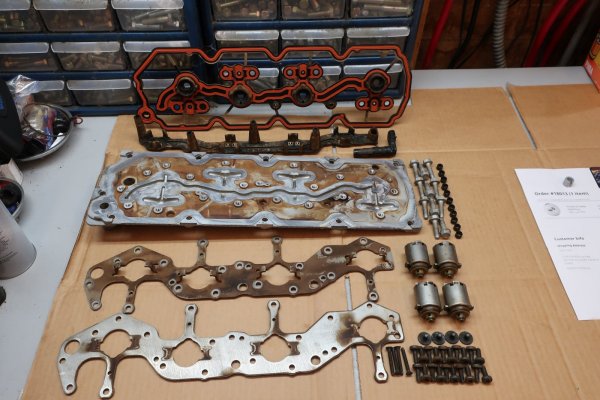
VLOM: gasket, electrical bridge, electrical connector receptacle, plate, solenoid retainer plate, gasket support plate, mounting bolts and hole spacers, solenoids, tower oil return screens, bridge mounting screws, retainer and support plate mounting screws.
Some assembly required.
I cut the center section out of the VLOM gasket, as I was going to use the new outer gasket. I did have a concern about this, though. The gasket center section is positively located on the VLOM plate by large plastic pins molded in. There were no locating pins in the outer perimeter gasket. I wasn't exactly sure how I was going to keep the new outer gasket properly aligned during installation. Luckily, the new outer perimeter gasket had two large plastic locating pins molded in that corresponded to recesses cast in the VLOM plate.
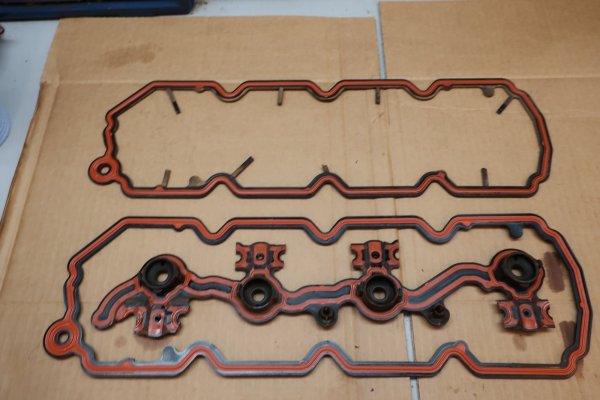
Gasket center section set in new outer perimeter gasket.
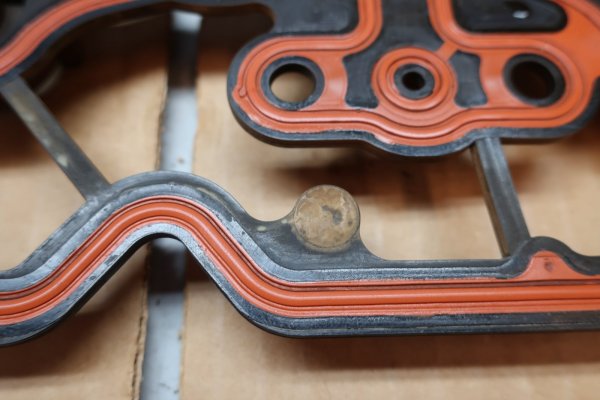
Tab on outer perimeter of original gasket was blank.
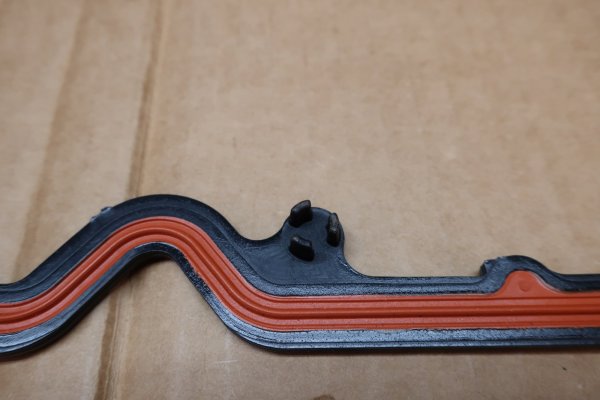
Tab on new outer perimeter gasket has a locating pin.
Before reassembling the VLOM, I performed the 'VLOM Mod' from Crazed Performance Repair.
Part of that involved cutting half off the sections of center section gasket that sat over the AFM lifter towers in the engine valley.
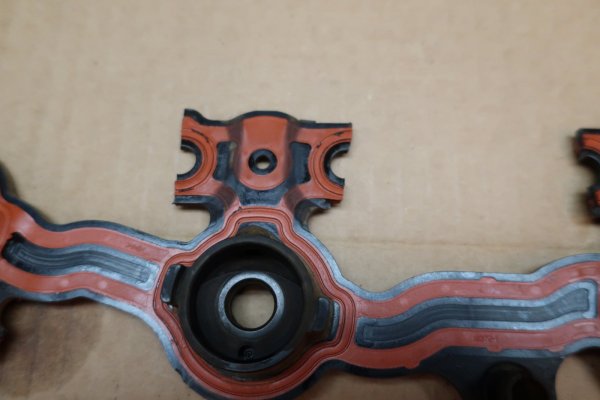
Center section gasket cut away at the areas that sit over the AFM lifter towers in the engine valley.
I took it apart. Mainly to do some cleaning. All parts except the solenoids, electrical bridge, gasket, and the electrical connector receptacle were soaked and then scrubbed in my parts washer. The solenoids and connector receptacle were wiped off with brake cleaner soaked rags. The bridge and gasket were quickly scrubbed in the parts washer and set to try.
My intent was not to get the parts surgically clean, but to remove the worst of the crud.
Word of caution: I had initially sprayed the gasket with brake cleaner and then wiped it off. Nothing bad happened. However, once I scrubbed it in the parts washer, the rubber elements started swelling. I hosed it down with brake cleaner again and wiped it off. After a couple of hours of drying, most of the rubber elements shrank back. That which was a little loose, I pushed back into place just before installing the gasket back on the VLOM plate. Honestly, I am not overly concerned about this. The center section gasket rubber elements sat properly in the plastic frame. More importantly, due to the sleeve I pressed into the oil pressure sending unit bore as part of the 'VLOM Mod', there is not supposed to be any oil pressure at the solenoids anymore.

VLOM: gasket, electrical bridge, electrical connector receptacle, plate, solenoid retainer plate, gasket support plate, mounting bolts and hole spacers, solenoids, tower oil return screens, bridge mounting screws, retainer and support plate mounting screws.
Some assembly required.
I cut the center section out of the VLOM gasket, as I was going to use the new outer gasket. I did have a concern about this, though. The gasket center section is positively located on the VLOM plate by large plastic pins molded in. There were no locating pins in the outer perimeter gasket. I wasn't exactly sure how I was going to keep the new outer gasket properly aligned during installation. Luckily, the new outer perimeter gasket had two large plastic locating pins molded in that corresponded to recesses cast in the VLOM plate.

Gasket center section set in new outer perimeter gasket.

Tab on outer perimeter of original gasket was blank.

Tab on new outer perimeter gasket has a locating pin.
Before reassembling the VLOM, I performed the 'VLOM Mod' from Crazed Performance Repair.
Part of that involved cutting half off the sections of center section gasket that sat over the AFM lifter towers in the engine valley.

Center section gasket cut away at the areas that sit over the AFM lifter towers in the engine valley.
skpyle
Full Access Member
- Joined
- May 15, 2021
- Posts
- 395
- Reaction score
- 1,025
The next part of the 'VLOM Mod' is a sleeve that presses into the oil pressure sending unit bore. This sleeve blocks oil pressure from flowing into the VLOM and to the solenoids. It is considered insurance against a leaking solenoid. The Black Bear tune ensures the solenoids are never energized to port oil to the AFM lifters to collapse them. This sleeve ensures there is no oil at the solenoids to be ported to the lifters in the event of a solenoid failure.
I like it, and it was only around $25 shipped.
Yes, I 'could' have fabricated something myself for cheaper. However, I chose to go this route.
The sleeve pressed in to the oil pressure sending unit bore with several taps from a brass hammer on a 10mm deep 1/4" drive socket. No muss, no fuss.
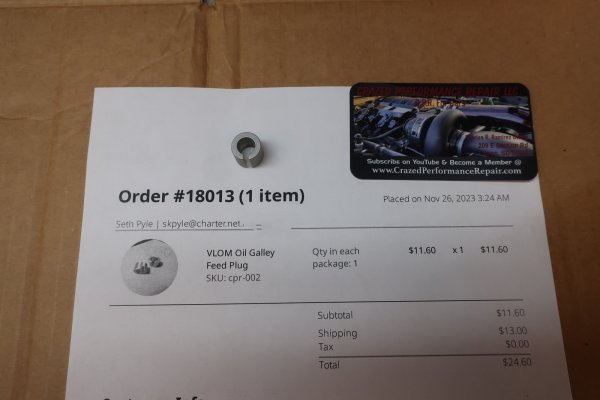
VLOM oil plug from Crazed Performance Repair.

Sleeve pressed into the bore, with the slot opposite the VLOM oil pressure supply port.
With that done, I reassembled the VLOM. Even though it has been disabled, I still took reassembly seriously. I tightened the solenoid retaining plate/gasket support plate bolts in a pattern starting from the center out. I looked up the torque spec for an 8.8 M6 x 1.0 screw thread and went with my little 1/4" drive torque wrench.
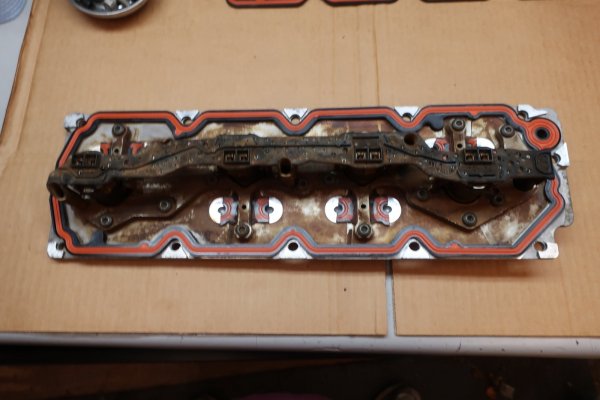
VLOM reassembled with 'VLOM Mod' performed and new outer perimeter gasket fitted.
VLOM right side up, I reinstalled the oil pressure sending unit. I left out the oil screen. It is not needed anymore, and doesn't fit with the sleeve pressed in. I did remember to reinstall the 11 bolt hole spacers for the mounting bolts.
NOTE: those little spacers are tiny and LIGHT! I chased a few of them across the work bench and on the floor...
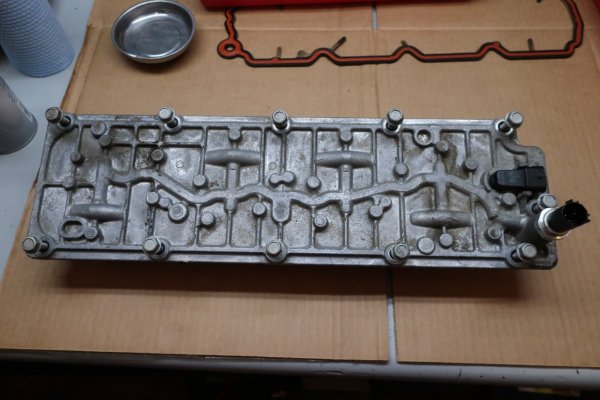
Completed VLOM with oil pressure sending unit, hole spacers, and mounting bolts installed.
Final step was to remove my 'custom' Rock Auto engine valley cover and install the VLOM. The locating pins for the new outer perimeter gasket were a loose fit, so the gasket did not stay up against the underside of the plate. I held it up with my fingers until it was just in place on the engine. Then ensured it hadn't shifted.
Service manual calls for 18 ft/lbs torque. 216 in/lbs on my 1/4" drive torque wrench, in a pattern starting from the center out.
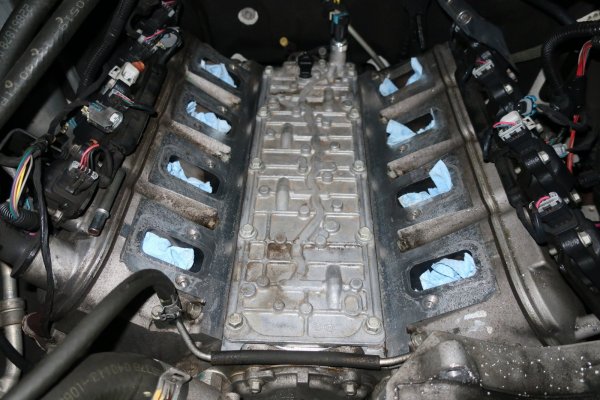
VLOM back in its home. Tight this time.
I like it, and it was only around $25 shipped.
Yes, I 'could' have fabricated something myself for cheaper. However, I chose to go this route.
The sleeve pressed in to the oil pressure sending unit bore with several taps from a brass hammer on a 10mm deep 1/4" drive socket. No muss, no fuss.

VLOM oil plug from Crazed Performance Repair.

Sleeve pressed into the bore, with the slot opposite the VLOM oil pressure supply port.
With that done, I reassembled the VLOM. Even though it has been disabled, I still took reassembly seriously. I tightened the solenoid retaining plate/gasket support plate bolts in a pattern starting from the center out. I looked up the torque spec for an 8.8 M6 x 1.0 screw thread and went with my little 1/4" drive torque wrench.

VLOM reassembled with 'VLOM Mod' performed and new outer perimeter gasket fitted.
VLOM right side up, I reinstalled the oil pressure sending unit. I left out the oil screen. It is not needed anymore, and doesn't fit with the sleeve pressed in. I did remember to reinstall the 11 bolt hole spacers for the mounting bolts.
NOTE: those little spacers are tiny and LIGHT! I chased a few of them across the work bench and on the floor...

Completed VLOM with oil pressure sending unit, hole spacers, and mounting bolts installed.
Final step was to remove my 'custom' Rock Auto engine valley cover and install the VLOM. The locating pins for the new outer perimeter gasket were a loose fit, so the gasket did not stay up against the underside of the plate. I held it up with my fingers until it was just in place on the engine. Then ensured it hadn't shifted.
Service manual calls for 18 ft/lbs torque. 216 in/lbs on my 1/4" drive torque wrench, in a pattern starting from the center out.

VLOM back in its home. Tight this time.
skpyle
Full Access Member
- Joined
- May 15, 2021
- Posts
- 395
- Reaction score
- 1,025
You may have noticed that I did NOT install the A37 bearing plugs into the AFM lifter towers in the engine valley.
I bought a bearing, and removed 8 rollers from it. I was on the fence about it, since my L94 is an aluminum block.

A37 wheel bearing rollers for plugs.
However...I learned a few things while searching about AFM, VLOM, and such.
OK, some (or most) of you already know this, but I will type it out here mainly for my own benefit.
Plugging the lifter towers is ONLY for non-AFM lifters! If you have done a full AFM delete and have non-AFM lifters in those positions, you must plug the towers. If you have AFM turned off in the system, but are still running AFM lifters, you must leave the towers open.
More on why in a moment...
I learned how AFM works:
In normal operation, an AFM lifter is held extended by locks inside the lifter. The AFM solenoids in the VLOM are deenergized, and any oil from the lifter bleeds out through return screens in the VLOM. All is good.
In V-4 mode, the VLOM solenoids are engergized. Pressurized oil is sent down the towers to the AFM lifters. This pressurized oil releases the locks inside the lifter. The lifter then collapses against the valve spring pressure when the cam lobe pushes the lifter up. As long is there is oil pressure in the towers, the lifters stay unlocked.
When AFM is turned off in the system with a tune or such, the VLOM solenoids never energize. So, pressurized oil is never sent down the AFM lifter towers to the lifters. However, it is possible (and likely given running clearances and manufacturing tolerances) for pressurized oil from the narrow lower band of the lifter to seep up the outside of the lifter body and work its way up into the tower. (NOTE: this is the oil used to pressurize the lifter to take up the running clearance in the valve train, IE what makes it a hydraulic lifter.) So, any oil that makes it up the tower has to have somewhere to go. The deenergized VLOM solenoids allow this oil to flow back out through the return screens. This is the same path used when an active AFM lifter is depressurized and allowed to lock again.
Plugging the holes in the AFM lifter towers in the engine valley blocks this path. It is possible for the oil that seeps past the lifter body to eventually pressurize the lifter and unlock it. Causing the lifter to collapse. And tick. And stay that way.
That is bad.
On the same token, installing a non-VLOM valley cover on an engine still running AFM lifters will result in the same scenario.
Still bad.
NOTE: the above mentioned return path to allow any oil that seeps past the lifter body is part of why I cut half the parts of the VLOM center section gasket that sits on the towers. This guarantees there is always a return path in case the tiny screens clog up with crud. This is part of the 'VLOM Mod.'
When an full AFM delete is performed, the AFM lifters are replaced with conventional LS lifters. These non-AFM lifters have a wide band on them for oil used for the 'hydraulic' function of a hydraulic lifter. This band is wide such that oil flows past it and up into the AFM towers. If the holes in the towers were not plugged, then there would be a massive drop in oil pressure.
That is also bad.
Hopefully that makes sense. It does in my head, and is why I did NOT install the plugs in the AFM lifter towers in my engine.
I bought a bearing, and removed 8 rollers from it. I was on the fence about it, since my L94 is an aluminum block.

A37 wheel bearing rollers for plugs.
However...I learned a few things while searching about AFM, VLOM, and such.
OK, some (or most) of you already know this, but I will type it out here mainly for my own benefit.
Plugging the lifter towers is ONLY for non-AFM lifters! If you have done a full AFM delete and have non-AFM lifters in those positions, you must plug the towers. If you have AFM turned off in the system, but are still running AFM lifters, you must leave the towers open.
More on why in a moment...
I learned how AFM works:
In normal operation, an AFM lifter is held extended by locks inside the lifter. The AFM solenoids in the VLOM are deenergized, and any oil from the lifter bleeds out through return screens in the VLOM. All is good.
In V-4 mode, the VLOM solenoids are engergized. Pressurized oil is sent down the towers to the AFM lifters. This pressurized oil releases the locks inside the lifter. The lifter then collapses against the valve spring pressure when the cam lobe pushes the lifter up. As long is there is oil pressure in the towers, the lifters stay unlocked.
When AFM is turned off in the system with a tune or such, the VLOM solenoids never energize. So, pressurized oil is never sent down the AFM lifter towers to the lifters. However, it is possible (and likely given running clearances and manufacturing tolerances) for pressurized oil from the narrow lower band of the lifter to seep up the outside of the lifter body and work its way up into the tower. (NOTE: this is the oil used to pressurize the lifter to take up the running clearance in the valve train, IE what makes it a hydraulic lifter.) So, any oil that makes it up the tower has to have somewhere to go. The deenergized VLOM solenoids allow this oil to flow back out through the return screens. This is the same path used when an active AFM lifter is depressurized and allowed to lock again.
Plugging the holes in the AFM lifter towers in the engine valley blocks this path. It is possible for the oil that seeps past the lifter body to eventually pressurize the lifter and unlock it. Causing the lifter to collapse. And tick. And stay that way.
That is bad.
On the same token, installing a non-VLOM valley cover on an engine still running AFM lifters will result in the same scenario.
Still bad.
NOTE: the above mentioned return path to allow any oil that seeps past the lifter body is part of why I cut half the parts of the VLOM center section gasket that sits on the towers. This guarantees there is always a return path in case the tiny screens clog up with crud. This is part of the 'VLOM Mod.'
When an full AFM delete is performed, the AFM lifters are replaced with conventional LS lifters. These non-AFM lifters have a wide band on them for oil used for the 'hydraulic' function of a hydraulic lifter. This band is wide such that oil flows past it and up into the AFM towers. If the holes in the towers were not plugged, then there would be a massive drop in oil pressure.
That is also bad.
Hopefully that makes sense. It does in my head, and is why I did NOT install the plugs in the AFM lifter towers in my engine.
I just skimmed the thread, but was going to say, do not in any way block the oil passage on the vlom side of the afm lifters.. they must vent oil or you will activate the afm lifter and collapse it. if you want to do the standard lifters sure. the factory spec got oil pressure is something like 5psi. in my opinion it totally doesn't need blocked but your call.
a guy here put a flat plate on a afm lifter engine and did just that. took 2 days for him working in a parking garage to release the lifter and put the vlom plate back on.
a guy here put a flat plate on a afm lifter engine and did just that. took 2 days for him working in a parking garage to release the lifter and put the vlom plate back on.
skpyle
Full Access Member
- Joined
- May 15, 2021
- Posts
- 395
- Reaction score
- 1,025
That's pretty much what I said.I just skimmed the thread, but was going to say, do not in any way block the oil passage on the vlom side of the afm lifters.. they must vent oil or you will activate the afm lifter and collapse it. if you want to do the standard lifters sure. the factory spec got oil pressure is something like 5psi. in my opinion it totally doesn't need blocked but your call.
a guy here put a flat plate on a afm lifter engine and did just that. took 2 days for him working in a parking garage to release the lifter and put the vlom plate back on.
skpyle
Full Access Member
- Joined
- May 15, 2021
- Posts
- 395
- Reaction score
- 1,025
Next goal was to refresh the cooling system.
I had added radiator cleaner solution to the cooling system approximately 2 weeks and 500 miles prior to taking my Escalade off the road. I had drained the radiator back in October of 2021, approximately 29,000 miles ago, so the coolant did not look too hateful.
Same thing this time, the coolant drained was still clear orange.
I will not get into the argument for/against Dexcool. For me, it works in my vehicles in which I take care of the cooling systems. So that is what I run.
Once the system was drained, I removed one heater hose from the water pump. And then poured 6 gallons of distilled water into that hose, the coolant reservoir, water pump ports on the block, and the upper radiator hose. Intent was to 'flush' the system.
Then, removal of all flexible coolant hoses in the engine bay, front steam bleed line, the godforsaken heater Tees, the coolant reservoir, and the water pump.
Again, all this work was preventative maintenance. The water pump wasn't leaking and appeared to be circulating coolant well. All the hoses were still pliable, and not deteriorated 'soft.' The heater Tees did not feel brittle. My Escalade always ran the needle right at the top middle of the coolant temperature 'gauge' and was always in the 19* degree range on the app.
So I believe the cooling system was in good shape.
All new GM Genuine parts went back in. I don't want to have to do this again for another 100,000 miles.
No real issues with any of it, other than the constant tension hose clamps. I have a tool kit of the various types of hose clamp pliers. It greatly helps, but the clamps are still a pain in the kazoo.
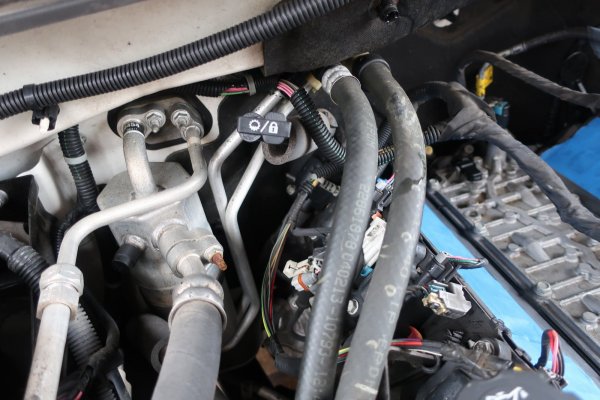

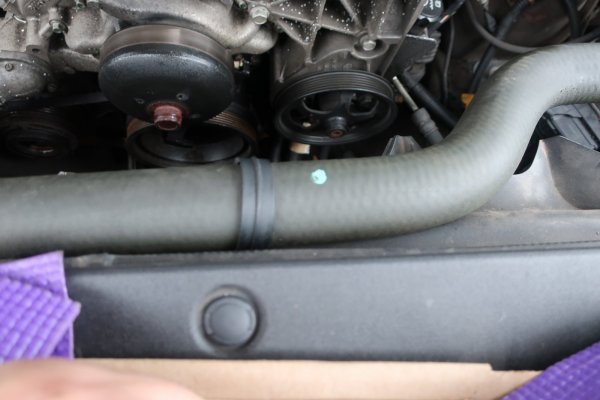
This plastic clip that secures the upper radiator hose to the fan shroud was an absolute bear to get apart.
None of the above coolant hoses looked bad at all.
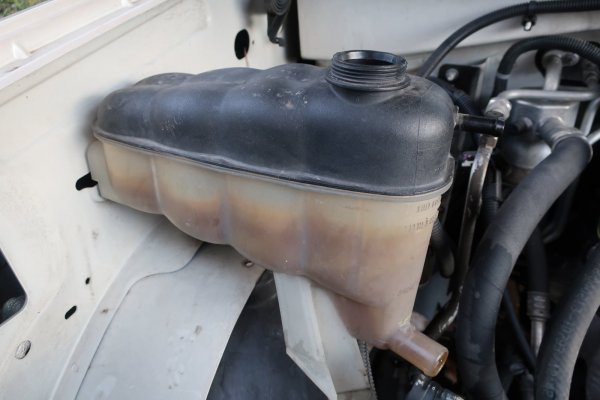
Coolant reservoir was stained and dirty.
And then...the Heater Tees.
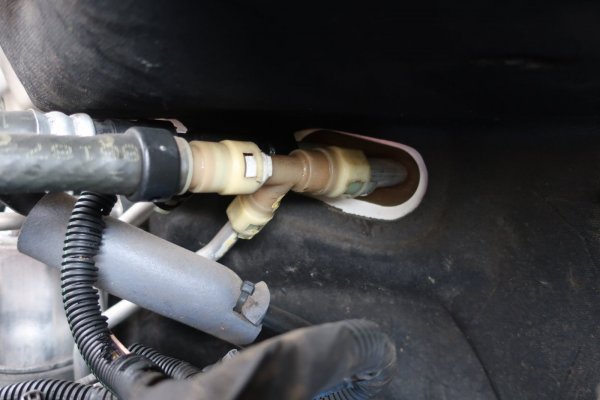
I had read many suggestions and tricks on getting the heater Tees off of a GMT900 here on TYF. Since I am uniquely gifted with luck, none of them worked for me. What finally did it for me was to reach in with both hands, right thumb and forefinger squeeze the release tabs as hard as I could, and left hand pull the hose off the Tee. In my case, the heater hoses and fittings came off, but the locks remained on the Tees. I then did the same procedure to release the Tees from the heater core lines in the firewall. Sounds easy. Was not. Compounded by the fact I am an idiot. When trying to release the white Tee, pulling on the black Tee does not work.
Once the Tees were disconnected from the heater core lines in the firewall, it became a twisting game to pull the them free and then be able to disconnect from the rear heater core lines.
I finally got them, though.
I had added radiator cleaner solution to the cooling system approximately 2 weeks and 500 miles prior to taking my Escalade off the road. I had drained the radiator back in October of 2021, approximately 29,000 miles ago, so the coolant did not look too hateful.
Same thing this time, the coolant drained was still clear orange.
I will not get into the argument for/against Dexcool. For me, it works in my vehicles in which I take care of the cooling systems. So that is what I run.
Once the system was drained, I removed one heater hose from the water pump. And then poured 6 gallons of distilled water into that hose, the coolant reservoir, water pump ports on the block, and the upper radiator hose. Intent was to 'flush' the system.
Then, removal of all flexible coolant hoses in the engine bay, front steam bleed line, the godforsaken heater Tees, the coolant reservoir, and the water pump.
Again, all this work was preventative maintenance. The water pump wasn't leaking and appeared to be circulating coolant well. All the hoses were still pliable, and not deteriorated 'soft.' The heater Tees did not feel brittle. My Escalade always ran the needle right at the top middle of the coolant temperature 'gauge' and was always in the 19* degree range on the app.
So I believe the cooling system was in good shape.
All new GM Genuine parts went back in. I don't want to have to do this again for another 100,000 miles.
No real issues with any of it, other than the constant tension hose clamps. I have a tool kit of the various types of hose clamp pliers. It greatly helps, but the clamps are still a pain in the kazoo.



This plastic clip that secures the upper radiator hose to the fan shroud was an absolute bear to get apart.
None of the above coolant hoses looked bad at all.

Coolant reservoir was stained and dirty.
And then...the Heater Tees.

I had read many suggestions and tricks on getting the heater Tees off of a GMT900 here on TYF. Since I am uniquely gifted with luck, none of them worked for me. What finally did it for me was to reach in with both hands, right thumb and forefinger squeeze the release tabs as hard as I could, and left hand pull the hose off the Tee. In my case, the heater hoses and fittings came off, but the locks remained on the Tees. I then did the same procedure to release the Tees from the heater core lines in the firewall. Sounds easy. Was not. Compounded by the fact I am an idiot. When trying to release the white Tee, pulling on the black Tee does not work.

Once the Tees were disconnected from the heater core lines in the firewall, it became a twisting game to pull the them free and then be able to disconnect from the rear heater core lines.
I finally got them, though.
Last edited:
Similar threads
- Replies
- 38
- Views
- 5K
- Replies
- 30
- Views
- 993
